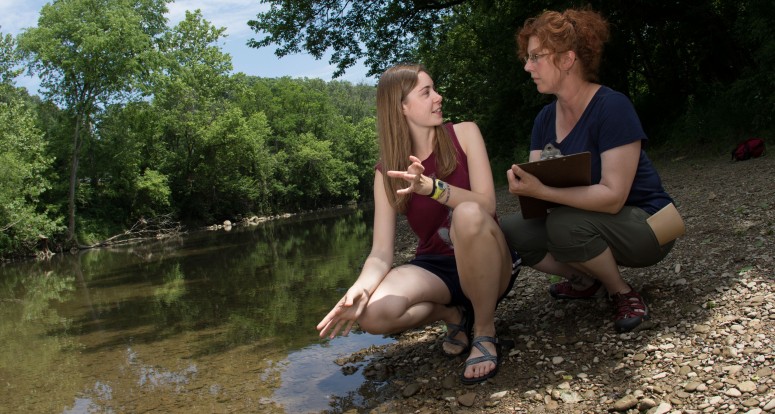Testing the Waters

Jennifer Seely '16 and Kimmarie Murphy, associate professor of anthropology
From Kenyon News - June 29, 2015
Above: Jennifer Seely '16 and Kimmarie Murphy, associate professor of anthropology.
Jennifer Seely ’16 sits by the Kokosing River near campus sometimes to reflect. Watching the water flow, she wonders whether tiny fibers from polyester clothing are collecting in the river.
She found those fibers in the Atlantic Ocean on a semester she spent on a research ship, sailing from Barcelona, Spain, to the Canary Islands off western Africa.
Through Kenyon’s Summer Science Scholars program, Seely is feeding her curiosity by taking water samples from various points along the river to examine for plastics, which also could include microbeads from soap or broken-down bits of larger items.
Research shows that plastics can release chemicals and are ingested by small river organisms, accumulating as animals are eaten up the food chain, Seely said. The polyester fibers are so small they slip through filters at water treatment plants and end up in waterways.
Seely, an anthropology major with a concentration in environmental studies from Mercer Island, Washington, also is asking nearby residents to take a survey on their opinions about the river and their habits of visiting, which she’ll consider alongside results of her river testing.
She is one of four dozen students who received a $3,500 stipend this summer for research projects, often working one-on-one with faculty members. After starting Summer Science Scholars in the 1980s, Kenyon is at the midpoint of a three-year pilot program to expand summer research into the humanities and social sciences.
Besides the sciences, students are studying legal issues, music, culture, literature and a variety of other topics through several programs: Summer Scholars for humanities and social sciences, the Democracy Scholars Program through Kenyon’s Center for the Study of American Democracy and the John W. Adams Summer Scholars Program in Socio-legal Studies.
Associate Provost Brad Hartlaub, professor of mathematics and statistics, said he was impressed with the collaborative projects in humanities and social sciences in the first year of the trial expansion. This year, the program received 12 applications for six slots.
“If the results from this year and next year are similar, then we will have a very strong case for expansion of the program. The one hurdle that we will need to cross is funding. These opportunities are fantastic for both faculty members and students, but they are expensive,” he said.
As a result of their summer research, students often give research presentations in a professional setting or publish findings for the first time, Hartlaub said. “Working with a faculty member in her or his research area is an opportunity that has changed lives for many students.”
Seely is getting help on her research from Professor of Biology Siobhan Fennessy, the Philip and Sheila Jordan Professor in Environmental Studies, who studies freshwater ecosystems.
Seely is aware that the Kokosing River is labeled as one of the most diverse and healthy rivers in the state by the Ohio Department of Natural Resources. “The Kokosing is a really clean river, and I might not find anything,” she said. But she points out that there has not been as much research on plastics in rivers as on oceans.
Kimmarie Murphy, associate professor of anthropology and the advisor on the project, said Seely is using anthropology’s strength of studying human behavior holistically, combining the natural science of testing the river with the social science of gauging how people use it.
“Jennifer is a perfect example of what a liberally educated person can do,” she said. “It’s that kind of thinking that you cannot teach if you go in with a silo mentality, and even if you go in with a discipline-specific mentality.”
If the survey finds the river has meaning to residents, Murphy said that could help Seely inspire change.
Read more about students’ summer research projects, including one that is documenting the experiences of Latinos in rural America.